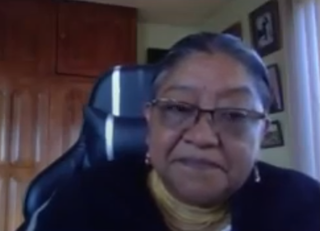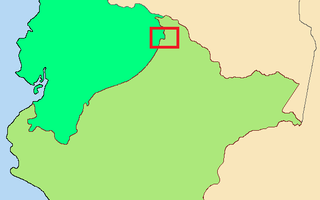Related Research Articles

Alfredo Pareja Diezcanseco — born Alfredo Pareja y Díez Canseco — was a prominent Ecuadorian novelist, essayist, journalist, historian and diplomat. An innovator of the 20th-century Latin American novel, he was a founding member of the literary Grupo de Guayaquil, which brought a new emphasis to realistic novels.

The Cara or Caranqui culture flourished in coastal Ecuador, in what is now Manabí Province, in the first millennium CE.
Esmeralda–Yaruro or Takame–Jarúroan, is a proposed connection between two unclassified languages of Venezuela and Ecuador: Yaruro, 6000 speakers, and the extinct Esmeralda. They would be only distantly related, but Kaufman (1990) finds the connection convincing, and Campbell (2012) believes the connection is promising.

Juan de Velasco y Pérez Petroche (1727–1792) was an 18th-century Jesuit priest, historian, and professor of philosophy and theology from the Royal Audience of Quito. He was born in Riobamba to Juan de Velasco y López de Moncayo and to María Pérez Petroche. Among the universities where he taught was the Universidad de San Marcos in Lima in the Viceroyalty of Peru. He is best known for his history book Historia del Reino de Quito, although he also wrote books in fields other than history, such as physics textbooks and poetry anthologies.

Jacinto Jijón y Caamaño was an Ecuadorian historian, archeologist, and politician. He was the mayor of the city of Quito from 1946 to 1948. He was a member of the Ecuadorian parliament and a candidate for the presidency of Ecuador. He published several works about the pre-Hispanic history of cultures in Ecuador.
Fernando Jurado Noboa is an Ecuadorian psychiatrist, historian and genealogist.
Gerardo Guevara is one of the key composers in Ecuador. His work combines native music with contemporary techniques.

Nina Pacari, born as María Estela Vega Conejo is a Kichwa politician, lawyer and indigenous leader from Ecuador.

Luis Alberto Costales Cazar was an Ecuadorian poet, philosopher, teacher, speaker, historian, farmer and politician.
Panzaleo is a poorly attested and unclassified indigenous American language that was spoken in the region of Quito until the 17th century.
The extinct Palta language of the Ecuadorian Amazon is attested by only a few words: yumé 'water', xeme 'maize', capal 'fire', let 'wood', and some toponyms. Based on this, Jacinto Jijón y Caamaño (1936) classified it as a Jivaroan language. Kaufman (1994) states that there is "little resemblance", but Adelaar (2004) finds the connection reasonable. In addition to these four words are toponyms, which commonly end in -anga, -numa, -namá. The latter two suggest the Jivaroan locative case suffix -num ~ -nam, and Torero (1993) notes that the last resembles Aguaruna (Jivaroan) namák(a) 'river' as well.

The Cacaopera people also known as the Matagalpa or Ulúa., are an indigenous people in what is now El Salvador and Nicaragua.

Rodolfo Pérez Pimentel is an Ecuadorian lawyer, historian, and biographer. He was declared the lifetime chronicler of the city of Guayaquil, and is a member of the National Academy of Ecuadorian History. He was the 2005 recipient of the Premio Eugenio Espejo in Literature, awarded to him by President Alfredo Palacio.

Aurelio Espinosa Pólit was an Ecuadorian writer, poet, literary critic, and university professor. He co-founded the Pontifical Catholic University of Ecuador, and he founded the Aurelio Espinosa Polit Museum and Library in Quito.

Luis Aguilar Monsalve is an Ecuadorian writer, critic, and professor emeritus at Hanover College in the United States.

María de las Mercedes Jijón de Vivanco y Chiriboga was the first First Lady of Ecuador, serving in that capacity twice alongside her husband, Juan José Flores.

Luis Enrique Marcial Gomezjurado Flores was an Ecuadorian painter, one of the most notable academic artists of the first decades of the 20th century. He specialized in the human figure and excelled in the portrait, also highlighted in Genre painting.

Carmen Febres-Cordero de Ballén (1829–1893) was an Ecuadorian writer and poet.

The Battle of Pantoja and Rocafuerte, known also simply as the Battle of Rocafuerte, was a military confrontation between Peru and Ecuador that took place on August 11, 1941, during the Ecuadorian–Peruvian War.
References
- ↑ "Indians and Leftists in the Making of Ecuador's Modern Indigenous Movements". www.yachana.org. Retrieved 2020-03-03.
- ↑ Rivadeneira, Alex (2023). "The Legacy of Concertaje in Ecuador". In Valencia Caicedo, Felipe (ed.). Roots of Underdevelopment. Cham: Springer International Publishing. pp. 127–162. doi:10.1007/978-3-031-38723-4_5. ISBN 978-3-031-38723-4.
{{cite book}}:|journal=ignored (help) - ↑ Antón Sánchez, John (2003). "Apuntes sobre la historia de los afrodescendientes en el Ecuador" (PDF). Cooperación Técnica BID ATN/SF-7759-EC (in Spanish). Archived from the original (PDF) on 2016-08-04. Retrieved 2017-01-08.
- 1 2 Henderson, Paul (1997). "Cocoa, Finance and the State in Ecuador, 1895-1925". Bulletin of Latin American Research. 16 (2): 169–186. doi:10.1111/j.1470-9856.1997.tb00049.x. ISSN 0261-3050. JSTOR 3339105.
- ↑ Martínez, Luis A. (1904). La agricultura ecuatoriana: obra publicada con el apoyo del Supremo gobierno (in Spanish). Impr. y Litograt̃ia de Salvador R. Porras. Retrieved 2023-05-29.
- ↑ Martínez, Luis A. (1897). La agricultura del interior : causas de su atraso y modos de impulsarla por Luis A. Martínez. Quito, Ecuador : Imprenta "La Novedad". hdl:10469/16213 . Retrieved 2023-05-29.
- ↑ Albornoz, César (2014). "La revolución que no redimió al indio ecuatoriano". Universidad Central del Ecuador (in Spanish).
- ↑ Almeida, Ileana (2005). Historia del pueblo kechua. Editorial Abya Yala. p. 229. ISBN 978-9978-22-537-0.
- ↑ Jacinto, Jijón y Caamaño. "De «Política conservadora» (Tomo I, págs. 97-209)". Jacinto Jijón y Caamaño (in Spanish). Biblioteca Virtual Miguel de Cervantes. Retrieved 2022-12-15.
- Alvarado, Pío Jaramillo (1954). El indio ecuatoriano (in Spanish). Editorial Casa de la Cultura Ecuatoriana . Retrieved 2023-05-04.
- Costales, Piedad Peñaherrera de; Samaniego, Alfredo Costales (1964). Historia social del Ecuador: El concertaje de indios y manumisión de esclavos (in Spanish). Editorial Casa de la Cultura Ecuatoriana . Retrieved 2022-09-19.